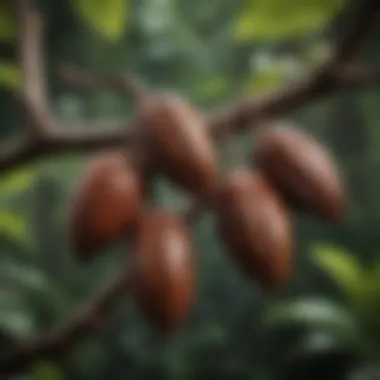Exploring Amazon Cacao: Origins and Impact


Intro
The relationship between humans and cacao transcends more than just a consumer product. Cacao, especially the variant found in the Amazon, carries with it a rich history and deep cultural significance. Understanding its origins, cultivation, and biochemical properties reveals layers of complexity that have implications for economic development, environmental sustainability, and even health.
In exploring Amazon cacao, one must begin with its botanical characteristics. The cacao tree, Theobroma cacao, thrives in humid tropical conditions and demonstrates a diverse range of genetic variations. These variations are crucial, as they not only influence flavor profiles but also determine the resilient traits against pests and diseases.
Additionally, the science behind cacao cultivation intertwines with socio-economic factors. Indigenous communities rely heavily on cacao for their livelihoods, relying on traditional farming practices passed down through generations. Examining these practices sheds light on the agricultural strategies adopted to enhance yield while respecting ecosystems.
This exploration does not merely serve academic interests. It connects to broader themes in environmental sustainability and public health. The cacao industry is often at the crossroads of ethical sourcing and environmental conservation.
Overall, the journey into Amazon cacao presents an opportunity to discern the intricacies of a crop that supports not only local economies but also global markets. The subsequent sections will expound on these themes with a focus on research highlights, original studies, and the socio-economic impact of cacao on the Amazonian landscape.
Preamble to Amazon Cacao
Amazon cacao is not just a crop; it carries layers of meaning that touch on history, culture, and the environment. Understanding this crop demands attention, as it plays a significant role in various sectors, from agriculture to health. The emergence of cacao in both local and global markets reflects profound implications for communities that depend on its cultivation and trade. In this narrative, we will carefully dissect the origins of this essential crop and its immense significance in today’s context.
Definition and Overview of Cacao
Cacao, scientifically known as Theobroma cacao, refers to the tropical tree whose seeds, known as cacao beans, are harvested for the production of chocolate and other products. The beans undergo various processes to transform them into the delightful treats many people enjoy today. Cacao is categorized into several types, including Criollo, Forastero, and Trinitario, each varying in flavor profile and genetic makeup.
The beans are rich in compounds that contribute to not just taste but health benefits. For instance, cacao is known to contain flavonoids, antioxidants, and various nutrients essential for health. Additionally, the potential for cacao to influence mental alertness and cardiovascular health has shown promise in recent research, meriting interest beyond just its culinary uses.
Historical Context and Cultural Significance
Historically, cacao has been so much more than a mere ingredient. Indigenous peoples of the Amazon region have cultivated this crop for millennia; its significance extends into spiritual and social spheres. Ancient Mesoamericans, such as the Maya and Aztecs, regarded cacao as sacred, using it in religious ceremonies and rituals. They even utilized cacao beans as currency in trade, signifying its substantial value.
In contemporary settings, the cultural importance of cacao persists, particularly among indigenous communities that continue traditional practices. Many still honor ancient methods of cultivation, believing these practices are crucial for spiritual health and communal identity. Cacao farming is often intertwined with local customs, reflecting the adaptive relationship between people and their environment.
"Cacao is not merely a crop; it is a bridge connecting generations, cultures, and ecosystems."
The intricacies of Amazon cacao highlight its role as a vital resource, sustaining livelihoods and preserving cultural integrity. As appreciation for chocolate grows worldwide, it is essential to recognize and understand the roots and ramifications of cacao's legacy. Considering the complexities of Amazon Cacao allows for a more comprehensive understanding of its impact on society and the environment.
Botanical Aspects of Amazon Cacao
The botanical aspects of Amazon cacao are crucial to understanding its overall significance. This section delves into the taxonomy and classification of cacao, as well as its morphological characteristics. Together, these elements provide essential insights into the functionality and value of cacao within its ecosystem and agricultural practices.
Taxonomy and Classification
Cacao is scientifically classified under the genus Theobroma, within the family Malvaceae. The full name is Theobroma cacao. This classification illustrates not only the plant's relation to other species but also highlights some evolutionary traits. It is vital for agricultural practices and research as it aids in identifying cacao's growth requirements, pest vulnerabilities, and genetic diversity. The distinction between different cacao varieties, such as Criollo, Forastero, and Trinitario, furthers understanding of its cultivation potential and flavor profiles.
This genetic diversity is important. It allows for breeding programs that can create hybrids with desired traits such as disease resistance or high yield. Knowing the taxonomy helps in stewardship practices within its native habitat, enabling conservation of unique strains that may be at risk of extinction.
Morphological Characteristics
Morphological characteristics refer to the visible structural features of the cacao plant. Each component—flowers, pods, and seeds—plays a role in the reproductive cycle and overall agricultural productivity.
Flowers
Cacao flowers are small and typically white or pinkish, blooming directly on the trunk or branches of the tree. This is called cauliflory. The key characteristic of cacao flowers is their unique ability to attract specific pollinators, primarily midges. Efficient pollination is crucial for fruit development and is central to achieving high yields.
One unique feature of cacao flowers is that they can yield multiple fruits from a single flower cluster. This can lead to higher productivity if the pollination conditions are favorable. However, the dependence on tiny insects for successful pollination poses challenges, especially in regions where their populations are declining.
Pods
Cacao pods are the structures that house the cacao beans. They are elongated and can range in color from yellow, green, red, to purple. A notable characteristic of cacao pods is their tough, leathery outer skin, offering protection to the precious beans inside. Pods can hold around 20 to 50 cacao beans each.
The unique feature of pods lies in their growth directly from the trunk of the tree. This trait is advantageous. It allows for easy harvesting, as the pods are reachable without needing special tools. However, the size and thickness can vary, which might complicate harvesting practices in certain cases.
Seeds
Cacao seeds are the beans themselves, which are the main product derived from the cacao plant. They contain vital chemical compounds and flavors. The key characteristics of cacao seeds include their high fat content, particularly cocoa butter, and the presence of bioactive compounds such as flavonoids. These traits contribute to cacao's economic and health significance.
A unique feature of cacao seeds is their ability to undergo fermentation after harvest. This process is essential for developing the rich flavors associated with various cacao products. The fermentation can also enhance health benefits linked to flavonoids, showcasing cacao's value beyond mere consumption. However, improper fermentation may lead to off-flavors, which can impact marketability.
In summary, the botanical aspects of Amazon cacao provide an essential foundation for various discussions on cultivation, environmental impact, and economic significance. Understanding taxonomy, flower attributes, pod characteristics, and seed properties allows stakeholders to optimize practices around this important crop.
"The intricate relationship between the morphological traits of cacao and its environmental adaptations underpins both sustainable practices and economic viability."
The insights gained from botanical studies encourage better cultivation techniques and sustainability practices, ensuring that cacao can thrive in both its natural habitat and agricultural settings.
Cultivation Practices


The topic of cultivation practices is essential in understanding the full complexity of Amazon cacao. The way cacao is cultivated has direct implications on quality, sustainability, and the socio-economic aspects surrounding its production. Planting methods, pest management, and harvesting techniques all play vital roles in ensuring that the cacao produced meets both market demands and environmental concerns.
Geographical Distribution
Geographical distribution encompasses the various regions where Amazon cacao is grown. The crop thrives in tropical conditions, making the Amazon Basin ideal due to its warm climate and ample rainfall. Other prime regions for cacao cultivation include parts of Central America and West Africa. By recognizing the areas that are best suited for cacao, we gain insight into how climate and geography influence its growth.
Key Fact: Cacao's ability to adapt to different elevations and soil types can lead to variations in flavor profiles, contributing to its global appeal.
Agronomic Techniques
Planting Methods
Planting methods significantly impact the success and productivity of cacao farms. Traditional approaches often involve planting cacao trees under the canopy of taller trees. This shade-grown method helps protect the delicate cacao plants from harsh sunlight and promotes a healthier ecosystem. Shade trees can improve soil quality and foster biodiversity, which can be beneficial in biological pest control. While this method is sustainable, it requires more space and patience compared to other methods where cacao is planted in direct sunlight.
Benefits of shade-grown cacao include:
- Enhanced flavor development due to slower growth.
- Improved resilience to climate fluctuations.
- Support for wildlife habitats which can aid pollination.
However, one downside is the reduced yield, particularly in younger plants, as they take longer to mature.
Pest Management
Effective pest management strategies are crucial for maintaining healthy cacao crops. Integrated pest management (IPM) combines various practices, including biological controls, cultural practices, and the selective use of pesticides. This method encourages the use of natural predators to manage pest populations, reducing dependency on chemical treatments.
A key characteristic of IPM is its adaptability, which can be customized based on the specific threats present in a given area. Benefits of effective pest management include:
- Reduced chemical runoff into local ecosystems.
- Enhanced crop resilience against pest attacks.
- Cost savings for farmers in the long run.
However, reliance on biological controls may not provide immediate results, requiring farmers to maintain a long-term perspective.
Harvesting
Harvesting cacao is a labor-intensive process that directly affects the quality of the final product. Cacao pods are typically harvested by hand using machetes to ensure that the pods are cut cleanly without damaging the tree. Timing is essential; pods must be harvested at peak ripeness to obtain the best flavor. This is often a knowledge passed down through generations.
Some unique features of cacao harvesting include:
- The need for workers to have trained eyes to identify the right pods.
- Attention to detail to avoid harming the tree itself, which can enable continued fruiting.
By ensuring proper harvesting techniques, farmers can significantly improve the quality of the cacao beans, elevating their market value.
The challenges faced in cacao cultivation require a holistic approach, focusing not just on output, but also on sustainability and the wellbeing of local communities. As we continue to explore the intricacies of Amazon cacao, it becomes evident that cultivation practices have far-reaching implications.
Biochemistry of Cacao
Understanding the biochemistry of cacao is essential for comprehending its diverse characteristics and profile. The chemical composition of cacao beans impacts both their flavor and potential health benefits. This analysis of cacao’s biochemistry forms the foundation for evaluating its use in food products and its nutritional value.
Chemical Composition of Cacao Beans
Flavonoids
Flavonoids are a significant component of cacao, known for their antioxidant properties. These compounds contribute to the health benefits associated with cacao, such as improving heart health and reducing inflammation. Cacao is rich in flavonoids like catechin and epicatechin. Their key characteristic is their ability to combat oxidative stress in the body. This makes flavonoids a popular topic in the health and nutrition discussion surrounding cacao. A unique feature of flavonoids is their potential to enhance blood flow. However, the extent of their health benefits may diminish during processing, which is a consideration for cacao product development.
Theobromine
Theobromine is an alkaloid found abundantly in cacao and is responsible for some of the stimulant effects associated with chocolate consumption. One of its key characteristics is that it can elevate mood and energy levels, making cacao a sought-after ingredient in various food products. The stimulant properties of theobromine can improve alertness without the jittery effects often associated with caffeine. An interesting aspect of theobromine is its role in cardiovascular health, supporting blood vessel dilation. However, it also poses risks for certain animals, particularly dogs, emphasizing the need for careful consumption.
Caffeine
Caffeine, while present in lower amounts compared to coffee, still plays a role in cacao. Its defining characteristic is its ability to stimulate the central nervous system, providing increased alertness. Though it is less concentrated in cacao than in coffee or tea, its presence contributes to the overall stimulant effect of chocolate. Caffeine’s inclusion in the discussion of cacao is essential as it leads to various health effects, like improved cognitive function. However, overconsumption can lead to negative side effects like anxiety and sleep disturbances, which are crucial considerations for consumers.
Processing Cacao into Products
Fermentation
Fermentation is a vital process in cacao production that influences flavor development. During fermentation, the pulp surrounding the cacao beans breaks down, which enhances the flavor profile. This process is key because it transforms the raw beans into a more palatable product. A notable benefit of fermentation is its role in developing complex flavors that are desirable in chocolate. However, inconsistent fermentation can lead to off-flavors, which presents a challenge for producers.
Drying
Additionally, drying is a crucial step following fermentation. This process ensures that cacao beans reach the proper moisture content for storage and transport, which is vital for maintaining quality. Drying contributes to flavor enhancement, as well, concentrating the desirable characteristics developed during fermentation. One unique advantage of proper drying is that it reduces the risk of mold during storage. On the other hand, excessive drying can lead to flavor loss, underscoring the need for precision in this stage.
Roasting
Finally, roasting is an integral part of processing cacao. This step brings out the rich flavors and aromas characteristic of chocolate. During roasting, chemical changes occur that enhance the bean's taste and texture. Roasting is essential because it allows for the development of the chocolate's final flavor profile. However, too high a temperature can lead to bitterness, which is a downside if not carefully monitored. Thus, mastering the roasting process is crucial for optimizing flavor while avoiding undesirable traits.


Economic Impact of Amazon Cacao
The economic significance of Amazon cacao cannot be overstated. It serves as a cornerstone for myriad communities, intertwining culture, tradition, and livlihoods. A detailed understanding of this impact lays the groundwork for grasping the multitude of benefits and considerations associated with cacao production and trade.
Global Market Trends
The cacao market is continuously evolving, influenced by shifting consumer preferences and increasing demand. The rise of craft chocolate producers has led to a growing recognition of specialty cacao, particularly from the Amazon rainforest. Highlighting this trend, the global demand for dark chocolate has surged, propelling prices higher for quality cacao beans.
Key aspects influencing these trends include:
- Sustainability: Consumers are increasingly concerned about the sustainability and ethical sourcing of cacao. This desire has prompted brands to emphasize fair trade practices and transparency in their supply chains.
- Health Awareness: With a growing awareness of health benefits attributed to cacao, such as antioxidants and flavonoids, sales in premium markets continue to rise, reflecting a dual focus on indulgence and wellness.
- Investment Opportunities: As cacao becomes an increasingly lucrative crop, investors are showing interest in sustainable cacao farming, viewing it as a means to capitalize on the growing health and ethical markets.
In summary, global market trends depict a shift towards valuing high-quality, sustainably sourced cacao. This trend reinforces the importance of Amazon cacao in not only economic terms but also as a pivotal player in the strategies of producers and consumers alike.
Local Economies and Employment
At the local level, cacao farming directly influences economies, particularly in remote Amazonian communities. Many farmers depend on cacao as their primary source of income. The cacao trade generates employment opportunities and fosters community development.
Several critical impacts include:
- Job Creation: The cacao supply chain provides jobs in various areas, including farming, processing, and distribution. This employment helps to alleviate poverty in rural regions, improving living standards.
- Cultural Heritage: Cacao cultivation is often tied to cultural practices and traditions that are passed down through generations. Preserving these practices can help maintain community identity and pride.
- Support for Small Scale Farmers: Many cacao producers are smallholders, and the rising demand for quality cacao opens doors for them in the global market. Small producers often band together to form cooperatives, which allows for better bargaining power and increased market access.
"Cacao farmers hold the keys to preserving not just an economic staple, but also a cultural treasure within Amazonian communities."
Environmental Considerations
Understanding the environmental impact of Amazon cacao is crucial for ensuring its sustainability. Cacao cultivation does not occur in a vacuum; it has profound effects on ecological systems that are intertwined with the livelihoods of communities dependent on this crop. Addressing these environmental considerations can guide more responsible farming techniques that preserve biodiversity, enhance ecosystem services, and mitigate negative impacts.
Sustainable Farming Practices
Sustainable farming practices in cacao production encompass methods that not only increase yield but do so while protecting the environment. Implementing agroforestry is one such practice. This approach involves growing cacao alongside other plants and trees, which helps to maintain soil health and prevent erosion. Additionally, shade-grown cacao supports a diverse ecosystem and reduces the need for synthetic fertilizers and pesticides.
Another aspect is the adoption of organic farming techniques. By avoiding chemical inputs, farmers protect local water sources and preserve soil organisms essential for nutrient cycling. Furthermore, sustainable practices like mulching and intercropping can help in maintaining a stable microclimate that benefits cacao trees.
Incorporating technology for precision agriculture can also enhance sustainability. Tools like soil moisture sensors and satellite mapping allow farmers to apply resources efficiently, minimizing waste and environmental degradation.
Biodiversity and Ecosystem Services
Cacao farming significantly interacts with local biodiversity and ecosystem services. A farm that integrates cacao with other species creates a habitat for various fauna, including birds and insects that contribute to pollination. This interconnectedness enhances the resilience of agricultural systems against pests and diseases.
Ecosystem services provided by healthy cacao farms include:
- Carbon sequestration: Cacao trees absorb carbon dioxide, helping to mitigate climate change.
- Soil protection: Diverse root systems prevent soil degradation and maintain soil fertility.
- Water regulation: Healthy tree cover supports watershed management, benefiting local communities.
"Incorporating biodiversity in agricultural systems is not just an environmental obligation; it is also an economic opportunity for farmers through increased resilience and productivity."
In summary, integrating sustainable practices in cacao farming and recognizing the importance of biodiversity can create a positive feedback loop that benefits both the environment and local economies. By fostering these principles, the cacao industry can thrive without compromising the ecological systems that support it.
Health Benefits of Cacao
The health benefits of cacao play a crucial role in understanding its value beyond being a mere ingredient for chocolate. This section examines how cacao can contribute significantly to overall health and wellness. The exploration offers insights into its nutritional profile and the potential therapeutic effects that it may provide. This is a pivotal part of this article, as it connects the science of cacao with its practical applications for enhancing human health.
Nutritional Profile
Cacao is notably rich in several essential nutrients that contribute to a healthy diet. It contains a good amount of dietary fiber, which aids in digestion. Additionally, cacao is a source of magnesium, iron, and antioxidants. Antioxidants, in particular, help in fighting free radicals in the body. Some significant elements found in cacao include flavonoids, theobromine, and small amounts of caffeine.
- Flavonoids: These compounds are linked with numerous health benefits, including anti-inflammatory effects. Flavonoids in cacao are thought to support heart health by improving blood flow and lowering blood pressure.
- Theobromine and Caffeine: Both of these substances can have stimulating effects. While caffeine is well-known for its energy-boosting properties, theobromine is gentler and may contribute to improved mood and alertness without the same level of jitteriness.
Potential Therapeutic Effects
The therapeutic effects of cacao have garnered much attention. Researchers have noted various ways in which cacao may benefit health, particularly concerning heart and cognitive functions.
Heart Health
Cacao's role in promoting heart health is one of its most recognized benefits. Consuming cacao-rich products is associated with lower risk of heart disease. This is largely attributed to its high flavonoid content. Flavonoids can enhance the function of blood vessels, thus improving circulation and reducing the risk of cardiac issues.
- Key Characteristic: The ability of cacao to enhance vascular health is a key aspect of its reputation. Lower blood pressure and improved circulation are particularly beneficial.
- Advantage: Regular consumption may lead to long-term heart health support without needing extensive medication or supplements.
Cognitive Benefits
Research indicates that cacao may also support cognitive function. The flavonoids present in cacao have been shown to enhance brain function. This could lead to improved memory and better overall cognitive performance.
- Unique Feature: The ability of cacao to influence blood flow to the brain distinguishes it. This increased blood flow may help in boosting memory recall and learning capabilities.
- Advantage: The potential for improved cognitive function can be especially appealing for students and professionals seeking an edge in mental performance.


"Cacao is not just a treat; its rich nutritional profile and health benefits make it an important part of a balanced diet."
Utilizing cacao in moderation could present numerous health benefits, reinforcing its importance in diets worldwide. The complexities of how cacao can impact health merit further exploration and research in order to substantiate these claims fully.
Challenges in Cacao Production
Cacao production is under continuous pressure from various challenges that can significantly impact both quality and yield. Understanding these challenges is crucial for the future of cacao as a vital crop, particularly in the Amazon region where it is deeply connected to local economies and ecosystems. The two main concerns in this sector are climate change and threats posed by pests and diseases.
Climate Change Impact
Climate change is an overarching issue affecting all agricultural production, and cacao is no exception. Changes in temperature and precipitation patterns can alter the delicate balance needed for healthy cacao growth. Higher temperatures may lead to increased heat stress, negatively impacting the development of cacao fruit. Meanwhile, irregular rainfall can create conditions unfavorable for pollination and flowering.
In addition to direct effects on the plants, climate change contributes to the increase of extreme weather events. For instance, excessive rainfall can cause flooding in cacao farms, leading to soil erosion and nutrient depletion. The alteration of growing zones may force farmers to adapt by cultivating cacao at higher altitudes, which might not have been considered before. Understanding local microclimates becomes vital for farmers and researchers alike to adapt cocoa production to these changes.
"Climate change alters agricultural systems profoundly, leaving producers to adjust or face significant losses."
Pest and Disease Threats
Pests and diseases are another major challenge for cacao production. The introduction of new pests, potentially due to climate change, can disrupt cacao farming. Common pests include the cacao pod borer, which can decimate yields by infesting pods.
Additionally, diseases like black pod rot caused by fungal pathogens can severely affect production. Farmers often have limited access to effective measures for pest and disease control due to resource constraints.
To combat these issues, investment in research for resilient cacao varieties is necessary. Integrated pest management strategies can also be beneficial to minimize losses while promoting environmental health.
Through a combination of adaptation strategies and improved practices, farmers may better navigate the multifaceted challenges of cacao production.
Future Directions for Amazon Cacao
Addressing the future of Amazon cacao is crucial for several reasons. As global demands for sustainable practices increase, knowing where cacao is heading innovatively is not just about business. It is about preserving a culture, enhancing biodiversity, and fostering environmental stewardship. The cacao supply chain is influenced by various factors, including climate change, market trends, and consumer preferences. Understanding these elements helps direct the future efforts in cacao cultivation and production.
Research and Development Needs
The realm of cacao is rich with potential for scientific exploration. Continued investment in research and development is necessary to overcome the challenges facing cacao farmers today. Developing resilient cacao varieties can help with climate adaptability. Research into genetic traits could lead to disease-resistant plants, which would significantly reduce the impact of pests and diseases.
Additionally, exploring new agricultural methods can enhance yield and quality. Practices such as agroforestry, organic farming, and efficient water use are worth studying further. Research initiatives can also focus on post-harvest techniques that maximize the quality of cacao beans, ensuring farmers receive higher prices in the market.
- Potential areas for research include:
- Genetic modifications for disease resistance
- Eco-friendly pest management strategies
- Innovations in fermentation and processing to elevate flavor profiles
Community Engagement and Ethical Production
Fostering community engagement is essential to ensure that cacao farming practices are ethical and sustainable. When farmers and local communities are involved in decision-making processes, it leads to better outcomes for everyone. Education programs should focus on teaching farmers about sustainable practices and effective business models. Ethical production not only improves farmers' livelihoods but also enhances the overall quality of cacao.
Involving local communities in the cultivation process helps preserve traditional methods while integrating modern practices appropriately. Promoting fair trade initiatives is pivotal for guaranteeing that growers receive fair compensation for their work. This creates a more robust local economy and fosters social equity.
"Sustainable cacao farming is not just an agricultural practice; it is a lifeline for many communities relying on it for their survival."
Future directions for Amazon cacao hinge on the collaboration between researchers, growers, and consumers. Only through collective efforts can we ensure that cacao remains a sustainable and profitable crop that respects both culture and environment.
Epilogue
The conclusion of this article distills the crucial takeaways regarding Amazon cacao, encapsulating its significance in various dimensions. It serves not just as a summary but as a reflection on the manifold interactions this crop engenders. Understanding Amazon cacao is essential for appreciating its contribution to cultural, economic, and environmental landscapes.
One key point lies in the understanding of cacao as a bridge between traditional practices and modern science. It highlights how indigenous knowledge and contemporary agricultural techniques can coexist to create sustainable practices. The exploration of health benefits also showcases cacao’s potential beyond mere consumption, hinting at its role in promoting wellness.
Another aspect is the economic influence of cacao production on local communities. This article emphasizes the importance of fair trade, ethical sourcing, and community engagement. Economic stability and social empowerment derived from cacao cultivation demonstrate its vital role in the livelihoods of those within these ecosystems.
Furthermore, addressing the challenges in cacao production, such as climate change and pest threats, points to an urgent need for innovative strategies. These considerations underline the importance of research and collaborative efforts for future resilience in cacao farming.
"Cacao is not just a product; it is a vital part of the Amazonian identity and ecosystem."
Overall, this concludes the comprehensive exploration of Amazon cacao, underscoring its multifaceted nature and the essential role it plays in our society today.
Summary of Key Points
The discussion surrounding Amazon cacao has unveiled several pivotal insights:
- Historical Significance: Cacao has deep roots within indigenous cultures, shaping traditions and economies.
- Agricultural Practices: Sustainable farming techniques are crucial for maintaining biodiversity and ensuring the future of cacao.
- Economic Impact: The global demand for cacao affects local economies, necessitating ethical approaches in trade.
- Health Implications: Research indicates potential health benefits associated with cacao, especially in cardiovascular health and cognitive function.
- Challenges Ahead: Climate change and pest pressures are significant threats, necessitating adaptive strategies.
Each of these points contributes to a holistic understanding of Amazon cacao’s relevance and future potential.
Implications for Future Research
The exploration of Amazon cacao leaves several avenues for future research. Major themes worth investigation include:
- Genetic Diversity: Research should explore the genetic variations within cacao species and how it affects resilience and productivity.
- Sustainability Practices: There’s a need to develop and evaluate new sustainable agricultural techniques that can mitigate the impact of climate change while enhancing cacao yield.
- Market Dynamics: Understanding the global market trends and consumer behavior can aid producers in aligning their practices with demand.
- Health Studies: More extensive clinical studies are needed to further explore the health benefits attributed to cacao, providing substantial evidence for public health initiatives.
Encouraging interdisciplinary research initiatives can further enrich our understanding of Amazon cacao and its place within the broader context of environmental science, health studies, and economic development.







